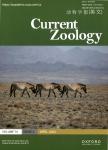Lower marine productivity increases agonistic interactions between sea lions and fur seals in Northern Pacific Patagonia
作者机构:Facultad de Ciencias BiologicasPontificia Universidad Catolica de ChileSantiagoChile Departamento de Ciencias BasicasFacultad de CienciasUniversidad Santo TomasOsornoChile Centro de Investigacion y Gestion de Recursos Naturales(CIGREN)Instituto de BiologıaFacultad de CienciasUniversidad de ValparaısoValparaısoChile Programa de Doctorado en Ciencias AgrariasEscuela de Graduados de laFacultad de Ciencias Agrarias y AlimentariasUniversidad Austral de ChileValdiviaChile Facultad de Medicina VeterinariaSede PatagoniaUniversidad San SebastianPuerto MonttChile Instituto de Ciencias BiologicasUniversidad de TalcaTalcaChile Department of PathobiologyOntario Veterinary CollegeUniversity of GuelphGuelphCanada
出 版 物:《Current Zoology》 (动物学报(英文版))
年 卷 期:2022年第68卷第6期
页 面:657-666页
核心收录:
学科分类:0710[理学-生物学] 07[理学] 071002[理学-动物学]
基 金:This work was partially funded by“Rufford Small Grants Foundation”(grant number 18815-1) Morris Animal Foundation(grant number D16ZO-413).
主 题:interspecific interactions climate change Guafo Island sea surface temperature South American fur seal South American sea lion
摘 要:Interspecific interactions are key drivers of individual and population-level fitness in a wide range of animals.However,in marine ecosystems,it is relatively unknown which biotic and abiotic factors impact behavioral interactions between competing species.We assessed the impact of weather,marine productivity,and population structure on the behavioral agonistic interactions between South American fur seals(SAFSs),Arctocephalus australis,and South American sea lions(SASLs),Otaria byronia,in a breeding colony of SAFS.We hypothesized that agonistic interactions between SAFSs and SASLs respond to biotic and abiotic factors such as SAFS population structure,marine productivity,and weather.We found that SASL and SAFS interactions almost always resulted in negative impacts on the social structure or reproductive success of the SAFS colony.SASL adult males initiated stampedes of SAFS and/or abducted and predated SAFS pups.Adult SAFS males abundance and severe weather events were negatively correlated with agonistic interactions between species.However,proxies for lower marine productivity such as higher sea surface temperature and lower catches of demerso-pelagic fish were the most important predictors of more frequent agonistic interactions between SAFS and SASL.Under the current scenario of decline in marine biomass due to global climate change and overfishing,agonistic interactions between competing marine predators could increase and exacerbate the negative impacts of environmental change in these species.



